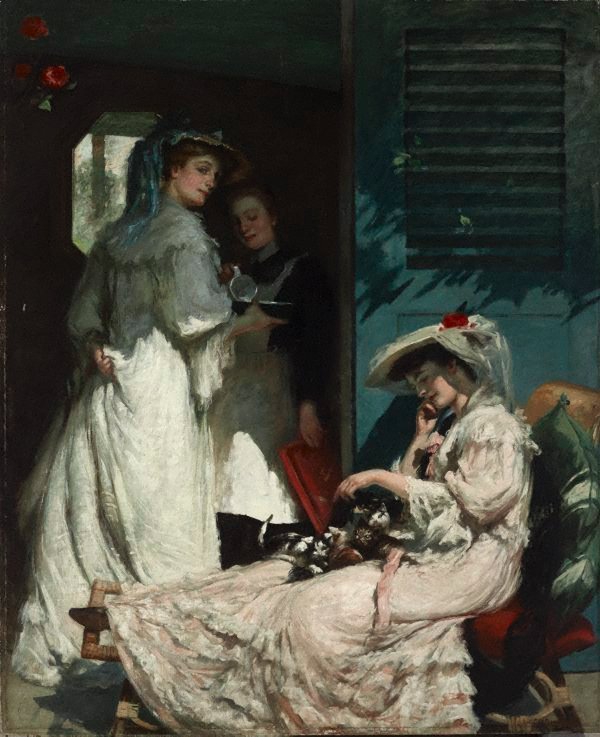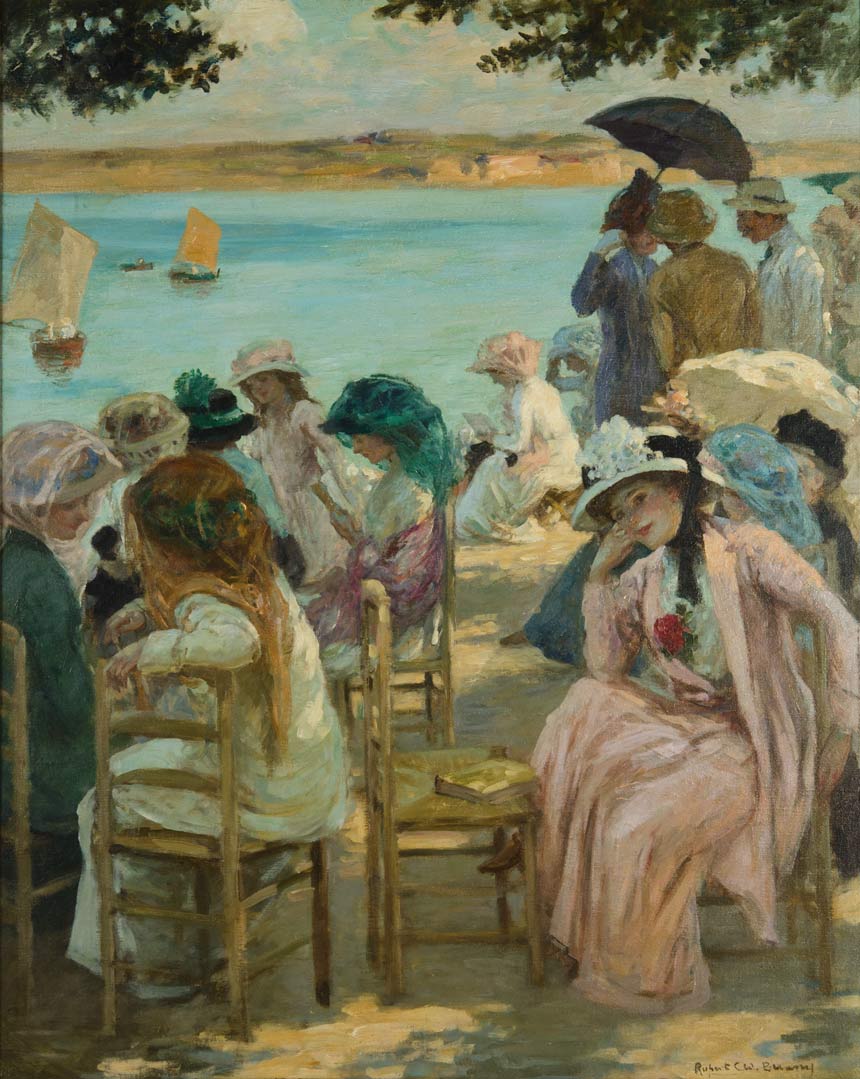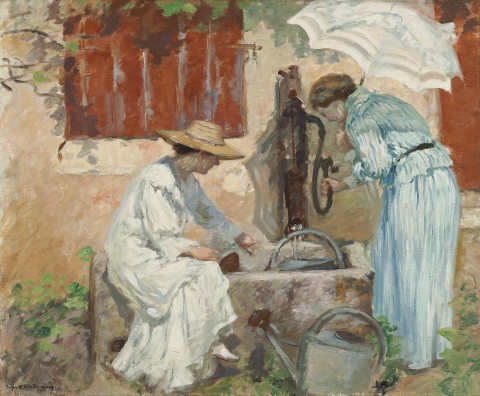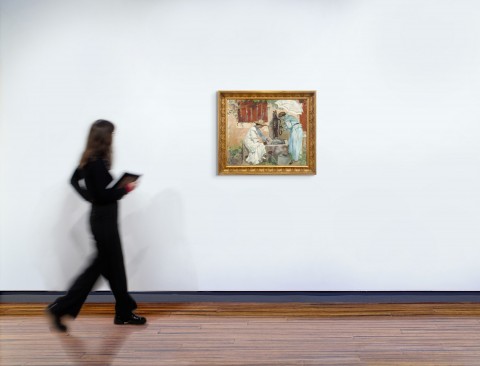AT THE PUMP, c.1908
RUPERT BUNNY
oil on canvas
60.0 x 73.0 cm
signed lower left: Rupert C. W. Bunny
inscribed with title on stretcher verso: At the pump
Anthony Hordern and Sons, Sydney
Private collection
James O. Fairfax AC, New South Wales, and Bridgestar Pty Ltd, Sydney
Important Australian Works of Art from the estate of the late James O. Fairfax AC, Deutscher and Hackett, Sydney, 30 August 2017, lot 17
Private collection, Sydney, acquired from the above
Exposition Rupert C. W. Bunny, Galeries Georges Petit, Paris, 10 – 31 March 1917, cat. 22 (as 'La Pompe')
Exhibition of Paintings by Rupert C. W. Bunny, The Fine Art Society Gallery, Melbourne, 15 – 27 November 1922, cat. 36
Exhibition of Oil Paintings by Rupert C. W. Bunny, Anthony Hordern and Sons, Sydney, 2 – 31 May 1923, cat. 36
Rupert Bunny Retrospective, Newcastle City Art Gallery, New South Wales, 31 July – 3 September 1968, cat. 8 (dated as c.1912)
Gleeson, J., 'The Art Collectors 3. James O. Fairfax', Art and Australia, Ure Smith, Sydney, vol. 3, no. 3, December 1965, pp. 174, 181 (illus., dated as c.1912)
Newcastle Morning Herald, Newcastle, 1 August 1968
Thomas, D., Rupert Bunny 1864 – 1947, Lansdowne Press, Melbourne, 1970, cat. 0155, p. 115 (dated as c.1913)
Thomas, D., The Life and Art of Rupert Bunny: A Catalogue Raisonné, Thames and Hudson, Melbourne, 2017, cat. O268, vol. II, p. 41
We are grateful to Brenda Martin Thomas, wife of the late David Thomas AM, for kindly allowing us to reproduce David's writing in this catalogue entry.
Rupert Bunny 1.jpg

The year 1908 introduces a period of special brilliance in Rupert Bunny’s art embracing such masterpieces as A Summer Morning, c.1908, in the collection of the Art Gallery of New South Wales, and the more personally sized Last Fine Days, Royan, c.1908, in the Newcastle Art Gallery. Paintings of enticing beauty such as At the Beach, c.1908 (private collection); Le Bel Après Midi, Royan, c.1908 (private collection); Shrimp Fishers at Saint-Georges, c.1908 (National Gallery of Victoria, Felton Bequest); and La Chenille Verte, c.1908 (once in the collection of Sir Reginald Marcus Clark), followed close upon each other. Bunny was at the height of his creativity, his beautiful wife Jeanne his muse and his model.
The evolution of some of these paintings is recorded in Bunny’s Villa Lili, St Georges sketchbook – figure studies of Jeanne patting a dog, feeding pet rabbits, or plucking a flower, together with compositional sketches for La Chenille Verte (The Green Caterpillar); The Cliff Path; and Oyster Gathering (St Georges).1 Jeanne and her lady companion feature throughout in sunny outdoor and interior scenes, or on a shaded balcony. The vivacity of handling increased in each successive painting to achieve the light-filled freedom characterised by The Swing, c.1913 (private collection).
Rupert bunny fine days.jpg

At the Pump, c.1908, together with a number of later paintings, was shown in Bunny’s exhibition at Galeries Georges Petit, Paris, in March 1917. According to the writer for the British-Australasian, the exhibition was ‘one of the biggest successes of the season.’2 Paintings were acquired by the French State for the Luxembourg Museum, and the exhibition was well reviewed by the Parisian critics. Arsène Alexandre wrote in Le Figaro: ‘never has this excellent painter displayed in his works such delicious colour, design, composition, meaning, imagination’.3 Gustave Geffroy, the noted French art critic, wrote the catalogue introduction.4 The appeal of Bunny’s paintings inspired him to comment: ‘These paintings are studies in colour and light and are also true and charming portraits of the actual presence of women whom the painter has observed in their homes and outside’. Commenting on Bunny’s ability to discover the ‘poetry of everyday things found in daily life’, Geffroy praised him for his presentation of images of adorned women ‘as quite natural’. He continued: ‘we are not surprised to see these creatures dressed in such splendour giving themselves up to modest occupations: drawing water, pruning roses, embroidering handkerchiefs or knitting stockings.’ Geffroy lauded Bunny as ‘a realist and a visionary, an observer of truth and a poet of the world of dreams.’5
Bunny is a painter of sunlight, sensuously caressing the flesh and fabric, and filling the canvas with a sparkling atmosphere of warmth and pleasure, an interest reflected in his oft-used title, ‘Sun Bath’. At the Pump celebrates this delight as a transient moment of the everyday captured in paint. As Jeanne watches her companion pump water to fill watering cans for the garden, the prosaic is transformed into the poetic by dancing touches of the brush, full of light and colour.
1. Villa Lili, St Georges Sketchbook II, c.1908, formerly in the collection of Dr Ewan Murray-Will, Sydney (and since broken up)
2. ‘Australian Artists in Paris’, British-Australasian, London, 11 March 1920, p. 12
3. Alexandre, A., ‘Informations – Aux Galeries Georges Petit’, Le Figaro, Paris, 24 March 1917, p. 3
4. A champion of Claude Monet, Geffroy was one of the first to write on Impressionism. Paul Cézanne painted his portrait in 1895.
5. Geffroy, G., ‘Rupert Bunny’, Exposition Rupert C. W. Bunny, Galeries Georges Petit, Paris, 1917
DAVID THOMAS


